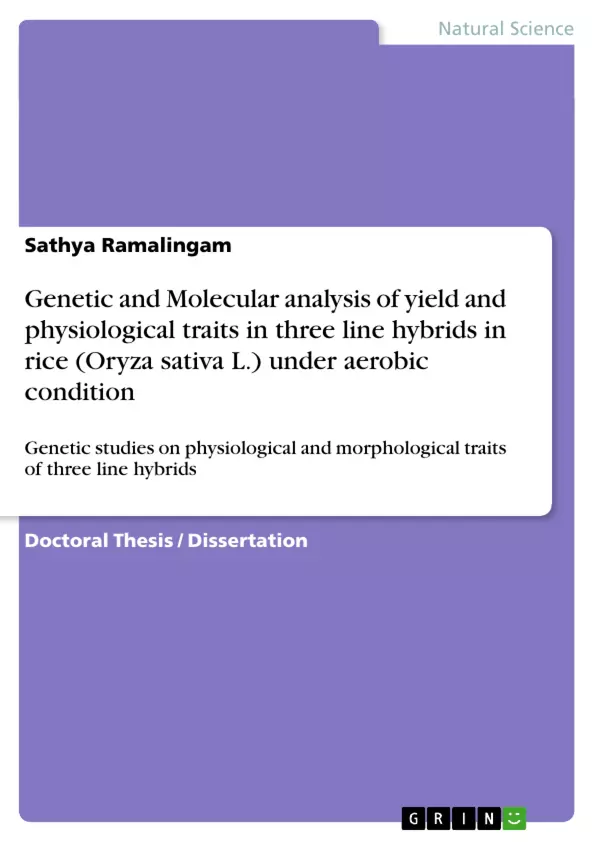Blick ins Buch

Genetic and Molecular analysis of yield and physiological traits in three line hybrids in rice (Oryza sativa L.) under aerobic condition
Genetic studies on physiological and morphological traits of three line hybrids
Doktorarbeit / Dissertation, 2012
329 Seiten
Leseprobe
Inhaltsverzeichnis (Table of Contents)
- Introduction
- Review of Literature
- Objectives
- Materials and Methods
- Experimental Results
- Analysis of yield and yield contributing traits
- Yield and yield components
- Harvest index
- Biological yield
- Genetic parameters and correlation studies
- Analysis of physiological traits
- Leaf chlorophyll content
- Leaf area index
- Net photosynthesis
- Transpiration rate
- Water use efficiency
- Genetic parameters and correlation studies
- Genetic diversity analysis using molecular markers
- DNA isolation
- SSR analysis
- Data analysis
- Association mapping of yield and physiological traits
- Discussion
Zielsetzung und Themenschwerpunkte (Objectives and Key Themes)
This thesis aimed to investigate the genetic and molecular basis of yield and physiological traits in rice under aerobic conditions. The study focused on three-line hybrids, a promising approach for enhancing rice production in water-limited environments.- Genetic variation and heritability of yield and physiological traits in rice under aerobic conditions
- Correlation and path analysis of yield and yield contributing traits, and their association with physiological parameters
- Identification of molecular markers associated with yield and physiological traits using association mapping techniques
- Evaluation of the potential of three-line hybrids for improving rice production under aerobic conditions
- Insights into the molecular mechanisms underlying adaptation to aerobic conditions in rice
Zusammenfassung der Kapitel (Chapter Summaries)
- Introduction: This chapter provides an overview of rice production and the challenges posed by water scarcity. It discusses the importance of aerobic rice cultivation and the potential of three-line hybrids for enhancing yield and stress tolerance. This chapter also includes a comprehensive review of the literature on the genetic and molecular basis of yield and physiological traits in rice.
- Experimental Results: Analysis of yield and yield contributing traits: This chapter presents the results of field experiments conducted to evaluate yield and yield components, harvest index, and biological yield in three-line hybrids. The study investigates the genetic variation and heritability of these traits and explores their correlations and path coefficients.
- Experimental Results: Analysis of physiological traits: This chapter delves into the physiological responses of three-line hybrids to aerobic conditions. It examines leaf chlorophyll content, leaf area index, net photosynthesis, transpiration rate, and water use efficiency. Genetic parameters and correlations between these traits are analyzed to understand their role in yield performance.
- Experimental Results: Genetic diversity analysis using molecular markers: This chapter focuses on the genetic diversity among rice genotypes using molecular markers. It describes the DNA isolation and SSR analysis procedures and presents the genetic diversity estimates and population structure analysis.
- Experimental Results: Association mapping of yield and physiological traits: This chapter explores the association between molecular markers and yield and physiological traits. It identifies markers linked to traits of interest, providing insights into the genetic basis of adaptation to aerobic conditions.
- Discussion: This chapter summarizes the key findings of the study, discusses their implications for rice breeding, and highlights the potential of three-line hybrids for improving rice production under aerobic conditions.
Schlüsselwörter (Keywords)
Rice, three-line hybrids, aerobic conditions, yield, physiological traits, genetic variation, heritability, correlation, path analysis, molecular markers, SSR, association mapping, water use efficiency, adaptation, breeding.
Ende der Leseprobe aus 329 Seiten
- nach oben
Details
- Titel
- Genetic and Molecular analysis of yield and physiological traits in three line hybrids in rice (Oryza sativa L.) under aerobic condition
- Untertitel
- Genetic studies on physiological and morphological traits of three line hybrids
- Hochschule
- Tamil Nadu Agricultural University (Madurai Agricultural College and Research Institute)
- Veranstaltung
- Ph.D
- Autor
- Sathya Ramalingam (Autor:in)
- Erscheinungsjahr
- 2012
- Seiten
- 329
- Katalognummer
- V201760
- ISBN (eBook)
- 9783656322269
- ISBN (Buch)
- 9783656325956
- Dateigröße
- 5146 KB
- Sprache
- Englisch
- Anmerkungen
- I thank my chairman Dr.S.Jebaraj, professor in department of plant breeding and genetics and Pioneer Hibred International for the award of $15000 for two years to carry out this research
- Schlagworte
- genetic molecular oryza
- Produktsicherheit
- GRIN Publishing GmbH
- Preis (Ebook)
- US$ 42,99
- Preis (Book)
- US$ 55,99
- Arbeit zitieren
- Sathya Ramalingam (Autor:in), 2012, Genetic and Molecular analysis of yield and physiological traits in three line hybrids in rice (Oryza sativa L.) under aerobic condition, München, Page::Imprint:: GRINVerlagOHG, https://www.diplomarbeiten24.de/document/201760
Allgemein
Autoren
- Autor werden
- Ihre Optionen
- Vertriebskanäle
- Premium Services
- Autorenprofil
- Textarten und Formate
- Services für Verlage, Hochschulen, Unternehmen
Premium Services
FAQ
Marketing
Dissertationen
Leser & Käufer
Zahlungsmethoden

Copyright
- © GRIN Publishing GmbH.
- Alle Inhalte urheberrechtlich geschützt. Kopieren und verbreiten untersagt.
- info@grin.com
- AGB
- Open Publishing
Über GRIN
Der GRIN Verlag hat sich seit 1998 auf die Veröffentlichung akademischer eBooks und Bücher spezialisiert. Der GRIN Verlag steht damit als erstes Unternehmen für User Generated Quality Content. Die Verlagsseiten GRIN.com, Hausarbeiten.de und Diplomarbeiten24 bieten für Hochschullehrer, Absolventen und Studenten die ideale Plattform, wissenschaftliche Texte wie Hausarbeiten, Referate, Bachelorarbeiten, Masterarbeiten, Diplomarbeiten, Dissertationen und wissenschaftliche Aufsätze einem breiten Publikum zu präsentieren.
Kostenfreie Veröffentlichung: Hausarbeit, Bachelorarbeit, Diplomarbeit, Dissertation, Masterarbeit, Interpretation oder Referat jetzt veröffentlichen!
- GRIN Verlag GmbH
-
- Nymphenburger Str. 86
- 80636
- Munich, Deutschland
- +49 89-550559-0
- +49 89-550559-10
- info@grin.com
-









